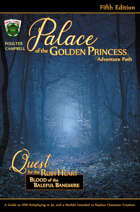 |
The seminal work on this topic is done by
Victor Raymond in Fight On #2 & #3 |
It's Citizen Kane all over again.
It says it
right on the cover of Dungeons and Dragons Volume 3 of Three Booklets: "The underworld and wilderness adventures."
"
The Wilderness:
The so-called Wilderness"
Those are the first five words Gygax wrote on the subject. Victor Raymond
makes it clear that the phrase "The Wilderness" doesn't mean the actual wild, but all non-dungeon content—dangerous wilds and other civilizations and civilized areas—that the players might encounter.
But what about the wild? The planes of fairy and the unknown? The mythical wood? The archetypical wilderness that threatens civilization? The line beyond which the cartographer writes, "Here, there be dragons."
Nearly every adventure published for Dungeons & Dragons follows these hidden and archetypal guidelines in design, here we are just going to uncover them and make them explicit. Strap in.
Awareness
People are breathing all the time, yet aren't really aware of it. There's this fundamental underlying structure to role-playing games, an archetypical truth, that we all know about yet remain unaware about.
Dungeons and Dragons is literally about taming the unknown. There's this central idea of a human narrative, where a person goes out into the unknown and retrieves knowledge and then returns. It's pretty central to the idea of us as a species, showing up again and again in psychology and fiction.
The basic structure of any role-playing game, is that players have a character. That character exists in a literal limbo, until the Dungeon Master utters a setting. Once within that setting (right after play starts) areas are delineated as adventure locations. I am speaking in categorical terms. An adventure location may be a scene, a conversation with a non-player character, or a cave entrance.
You are, sitting at the table, in possession a character, and several adventure options. You have an idea of your current (safe) location, which you leave to engage with the adventure option.
The adventure is fundamentally about exploring these unknown spaces. What's in the cave? What does this person think? You uncover the unknown. Literally. The majority of Dungeons and Dragons play is exploring dungeons, which are represented as darkness or blankness and then are filled in as we explore. What's more, you are given a score for this activity; (or alternately the activity allows you to acquire a score). When you return successful, this score allows you to become a better explorer of the unknown.
This is a fundamental human instinct. We go absolutely bonkers for frontiers. How exciting is the boundary between what is known and unknown! And here's a whole game where the entire structure of play is focused on rolling back the frontier!
If you're wondering,
that is why 95% of role-players are playing Dungeons and Dragons or some derivative thereof.
Hell, Gygax figured it out, wrote down his excellent system of handling this from his seat of understanding, and then it was immediately misconstrued and lost, ignored by almost all, leaving us to discuss endlessly what's going on with hexes, and coming up with iterations like pointcrawls.
Archetypal Assumptions
A lot of this work proceeds from the excellent guidelines and overview provided by
Victor Raymond. I encourage you to read his articles in Fight On #2 and #3 on this topic. For now, let's have an overview of his key points.
First, the wilderness doesn't refer to the mythical wild, but rather
all uncivilized AND civilized areas that are unknown to the players.
Second, barring travel through the wilderness, a topic well covered in AD&D, other styles of wilderness adventure mentioned by Gygax include "
Exploratory Adventures" and "
Clearing the countryside of monsters"
Third,
20 miles is given as the amount of territory a stronghold can keep clear of monstrous influence.
Fourth, don't treat the wilderness as generic. Think of it as a collection of
places and
conditions. No terrain is "Forest" or "Hills" It's old rotted oaks, with a matting of decaying leaves, or mostly bare hills, with steep sides covered in grass and moss.
This is the core of his analysis that we are going to build off of.
The first thing to note is that the idea of wilderness is adjacent to chaos. The original game had three alignments, because the original game was about the conflict between law, and the rise of civilization, versus chaos, the wilderness and the unknown. The players are almost universally lawful, because their very actions involve imposing order upon the world (by discovering new territory and killing monsters).
That is the
Terminus Est. Dungeons are pockets of chaos that exist within civilized lands (usually close enough to be within the 20 mile range of safety). The Wilderness is the chaos beyond.
The third Original Dungeons and Dragons book outlines the entirety of adventure. You can adventure in the Underworld or the Wilderness.*
Apotheosis
So, what use is this?
Concretely, D&D is a game, organized as a collection of procedures.
Designing a wilderness: This is covered in the article by Victor, but needs little description. You can generate a wilderness yourself, or use phenomenal online tools, or use pre-existing maps. This topic is extensively covered.
Travel to a destination: This is also very explicitly covered. This is where the wilderness rules for getting lost apply, wilderness encounter tables are used, and where hexmaps at a scale of 25-60 miles are useful.
An Aside:
in food, lives, and loss.
Having unique systems for unique terrain greatly enhances this mode of play.
(That link leads to the marvelous wilderness mini-games by Telecanter)
Exploratory Adventures: This is the process of discovering the lay of the land. This procedure is outlined in Volume 3.
"
When players venture into this area they should have a blank hexagon map, and as they move over each hex the referee will inform them as to what kind of terrain is in that hex. This form of exploring will eventually enable players to know the lay of the land in their immediate area. . . Scale: Assume the greatest distance across a hex is about 5 miles. Turn: Each move will constitute one day. Each day is considered a turn. At the end of each day, the referee will check to see if a monster has been encountered. "
This assumes, of course, that the Dungeon Master is using a map with already labeled castles/strongholds. If that's not the case, the essential
CDD #4 Old School Encounters Reference places fortresses at about a 1 in 20 chance per hex.
Essentially this exploration allows the players to both identify the terrain of the hex and informs them as to an outstanding features of the hex—is there a castle? a lair? a tribe of humanoids? It seems like the type of adventure for 7th-8th level players to engage in.
Clearing a hex: This process is clarified on page 24 of ODD.
"
Clearing the countryside of monsters is the first requirement. The player/character moves a force to the hex, the referee rolls a die to determine if there is a monster encountered, and if there is one the player/character's force must remove it. If no monster is encountered the hex is already cleared. Territory up to 20 miles distant from a stronghold must be kept clear of monsters once cleared—the inhibition of the stronghold being considered as sufficient to maintain the monster-free status."
What does this mean logistically? You have to clear the site of your castle, and out to four hexes in every direction (at 5 miles a hex). That's 95 hexes, for an average of 16 encounters. Here are the 8 encounter options presented for a forest hex:
1. Men (30-300)
2. Flyer (Ex. Rocs 1-20)
3. Giant (Ex. Orcs (30-300)
4. Lycs (2-20 werewolves)
5. Lycs. (2-20)
6. Men (30-300)
7. Anmls. (Ex. 10-100 pixes)
8. Dragon
So, you can see that clearing 20 miles may present a bit of a challenge.
This provides a core of wilderness play. It covers design, travel, discovery, and taming. A process for pushing back the frontier. acquiring territory, and moving into conflict with other fortresses and lords.
As complete as this is, there is still something missing.
Avidity
What we have is not enough. We need more. What of the mythical unknown?
One of the stipulations that Victor notes in his search for when the wilderness encounter table is used is that even though those 20 miles may be cleared, the wilderness always encroaches. So from 0-5 miles you roll city encounters. From 6-10 miles you might have level 1 dungeon encounters on the list. From 11-15 miles you might have level 2 dungeon encounters on the list, and from 16-20 miles you might have level 3 encounters.
The other thing he notes is that dungeons, often, lie within civilized lands.
So what we are left with is the idea that "exploring" and "clearing" the hexes just addresses the proud nails. What's left is suitably wild, though perhaps not of particular interest to name level characters.
So in addition to having unexplored dungeons in civilized lands, and somewhat more controlled groups of monsters (maybe a gnoll raiding party numbering 20, versus the 220 gnolls the lords killed), you can also have pockets of mythical wilderness!
This is where pointcrawls and zones (to avoid the genericness of area) come into play. The general idea is, much like the dungeon is an area of high resistance, so is the mythical wilderness.
In each hex are four possible kinds of areas.
Bastions of civilization,
rolling terrain covered with wandering monsters—the local ecology—not power groups that are rolled for and cleared when clearing or exploring,
point crawls which are mythical wilderness-style areas that are treated as areas of ineradicable wildness and magic. And finally
zones, (usually at the many points of a pointcrawl) which are simply small maps (like dungeons and ruins) that are uncovered and cleared (though the possibility of restocking always exists). Zones are usually dungeons, but treating ruins, abandoned keeps, and small clearings, caves, and lairs as alternate zone types provides a lot of variety on the players end. Reference the video games Baldur's Gate 1 & 2 (or any of it's many spiritual descendants) for exceptional and creative use of zone wilderness design.
Hexes fail when applied to finer terrain. This is the key insight behind the development of pointcrawls as a middle point between Zone style play and hexploration. It is simple. The 6 mile-hex is our minimum structure. Our atom. You can't subdivide it into further atoms without serious issues. So instead, we deal with the hex as having an interior structure made up of structures, people, and sites.
("Citadels & Castles”, “Ruins & Relics”, “Idyllic Islands” and “Lurid Lairs”.) Once located within the hex, each represents a point, with the distance between covered by wandering monster checks, weather, and a
specific one-line description of the terrain.
Voilà! It's game structures all the way down.
But how to maintain that sense of discovery? Where is the wonder and awe in exploring the wilderness. This idea must feed back into design.
We must assume that even though the hex is cleared, that this has only eliminated major threats. Smaller, hidden threats, can still be present. Secondly, in addition to many landmarks being visible on the hypothetical pointcrawl, many should not be, and should only be locatable by actually visiting the location. The fact that the landmarks visible are not sequential (they have more to do with their location and visibility in the hex) means the path through the pointcrawl to them, as well as other features remain hidden to be discovered by the players during exploration. Finally, there can be both obvious and unobvious paths, much like secret doors, requiring either foreknowledge or wilderness expertise to locate.
Further, this is what differentiates wilderness exploration from dungeon exploration. When you begin wilderness exploration, many landmarks are already visible, as opposed to all being obscured by the dungeon.
The above outlines the core of the adventure within wilderness exploration.
The following amazing resources are some of what I use in play and design.
CDD#4 Old School Encounters Reference
Telecanter's Wilderness Travel Mini-games and challenges
Telecanter's list of Geographic Wonders
*
It's important to note here, that by no means did Gygax exclude the idea of chaos being inimical to civilization. He also postulated exploring cities as adventure, because there are types of chaos that can lie beneath a veneer of civilization. As noted in the possible city and castle encounters, he included the unknown city interior as wilderness.
Also, I'm able to spend time working on these topics thanks to your support. If you liked this article and want to see me continue to produce content, please support me on Patreon! Thanks for keeping me from starving to death!




